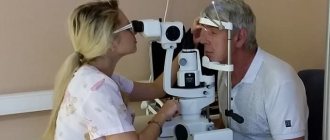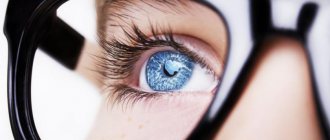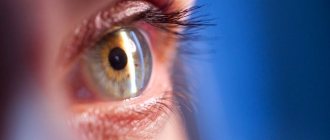Replacing the lens for cataracts is an effective way to improve visual acuity and get rid of the disease.
To maintain the result and healing in the postoperative period, you should adhere to the surgeon’s recommendations and restrictions.
To prevent postoperative complications, special eye drops are prescribed that have antibacterial, anti-inflammatory and analgesic effects. Multivitamin supplements may be recommended.
One of the measures for better healing of the implanted lens is following a diet and a number of restrictions, wearing special glasses. All medications are used as prescribed by a specialist, depending on the age, condition of the patient, and the presence of other diseases in the anamnesis.
Duration of the rehabilitation regime
The duration of the postoperative period varies depending on the patient's age, the intervention performed (laser surgery, surgical method, IOL implantation) and the stage of the cataract, the patient's health status and compliance with recommendations. The quality and characteristics of the intraocular lens are affected.
On average, complete recovery after cataract removal and regeneration takes 6 months.
The rehabilitation period includes 3 stages with their own limitations:
- the first stage lasts 7 days - during this time you cannot wash your hair or wash your face, you can wipe your face with cotton swabs moistened with water, disinfectant and antibacterial drops are used;
- the second stage begins on the 8th day after the operation and lasts until the 30th day - a gentle regimen after the operation is indicated;
- third stage up to 6 months after surgery.
What is secondary cataract?
The reoccurrence of secondary cataracts is characterized by clouding, hardening and loss of elasticity of the posterior capsule of the lens of the visual system. It leads to a deterioration in a person’s ability to clearly see the world around them.
In modern ophthalmology, when removing cataracts, it is customary to preserve the capsule by implanting a prosthesis (artificial lens) into it. Subsequently, secondary opacification may occur not on the implanted lens, but directly on the posterior wall of the capsule,
In this article
- What is secondary cataract?
- Reasons for repeated opacification of the capsule with an implanted lens?
- Symptoms of opacification of the posterior wall of the capsule
- Laser removal of secondary cataracts
- Possible complications after laser surgery
- Is it possible to drive a car after laser dissection of the posterior capsule?
- Contraindications to the procedure
preserved after the first surgical intervention in the visual system. This pathology is quite common among people who have already undergone surgery to replace the lens and eliminate cataracts. Studies show that posterior capsule opacification occurs in 30-40% of patients within 2-6 years after the procedure. Most often this occurs at an early age; older people are less susceptible to developing the anomaly.
Main rules of rehabilitation
Postoperative behavior includes:
- use of recommended eye drops;
- taking vitamin and mineral complexes for the eyes, which ensure better recovery of the eye and the body as a whole;
- compliance with the regime.
It is recommended not to overexert yourself mentally and physically, limit visual stress, and get more rest.
Eye drops
To restore vision after surgery and prevent the development of complications, the following groups of eye drops are used as prescribed by a specialist:
- anti-inflammatory drugs (NSAIDs) (Diclofenac, Diklo-F, Nevanac, Indocollir, Indomethacin);
- antibacterial (Ciprofloxacin, Tsipromed, Tobramycin, Tobrex);
- regenerating (Taufon, Korneregel, Solcoseryl eye ointment);
- antihistamines and corticosteroids (Dexamethasone, Maxidex);
- combination drugs (Dexa-Gentamicin, Tobradex, Sofradex, Maxitrol).
The duration of use of anti-inflammatory and antibacterial drops is 5-7 days. If there are complications, the course is increased. The frequency of use depends on the drug prescribed and averages 3-5 times a day. As recovery progresses, the frequency of instillations decreases.
When instilling, it is necessary not to touch the eye with the pipette and immediately close the bottle after use to prevent the development of an infectious process and the proliferation of bacteria on the container with the drug.
When using several drugs in the form of eye drops, it is necessary to observe a 5-10-minute break between installations.
Vitamin complexes
For a speedy recovery, maintaining visual acuity and restoring the functionality of the organ, an additional measure is to take multivitamin complexes. Use in a course of 1 to 3 months. It is especially recommended for use at risk of developing secondary cataracts, for elderly people, and in severe stages of the disease.
Prescribed drugs and dietary supplements:
- Strix;
- Okuwait;
- Blueberry forte;
- Blueberry forte with lutein;
- Vitrum Vision;
- Okuwait forte;
- Retinorm;
- SuperOptic.
It is possible to use general strengthening multivitamin complexes - Complivit, Bio-max, Vitrum, Selmevit, Bion 3. For the central region of Russia, the recommended drug is Bio-Max.
Compliance with the regime
For better recovery after surgery, you should get good sleep, at least 8 hours a day, rest, minimize visual stress - exclude or limit reading, especially small print, watching TV, working at a computer monitor.
The maximum duration of visual load on the organ should not exceed half an hour to an hour.
In the first days after surgery, it is not advisable to go outside. If necessary, wear a special bandage to prevent dust particles and foreign bodies from getting into the eyes, exposure to ultraviolet rays and other factors that provoke complications.
Can I watch TV after cataract surgery?
Almost immediately after phacoemulsification, the patient returns home, where he leads a normal lifestyle with some adjustments. For a month, he is advised not to overstrain his eyes, so as not to cause possible complications. You can watch TV within 3 hours after the operation is completed. But you must follow some rules:
- Don't spend more than two hours a day in front of a screen.
- Watch from a distance (1.5-2 meters).
- Take breaks from watching.
As the patient recovers, restrictions will be lifted. Most likely, in a month you will be able to watch TV in the amount that is necessary. As a rule, by this time the eyes are completely restored. To speed up the healing process and enjoy your favorite TV shows without restrictions, follow your doctor’s recommendations in full!
Find out what questions to ask your ophthalmologist at your first consultation.
Find out the answers to the most frequently asked questions about cataract surgery.
Learn about the recommendations to follow after surgery.
ARTICLES ON THE TOPIC: Complications of overripe cataracts Causes of cataracts in young people Brown cataract causes After cataract surgery what vitamin drops Consequences of cataract removal
Restrictions after cataract removal
Life after surgery undergoes changes until the final healing and stabilization of the condition.
Prohibited:
- after cataract surgery, you should not watch TV for a long time; it is better to exclude it from possible pastime;
- sleep on the side of the operated eye;
- apply decorative cosmetics to the eyelids and eyelashes;
- drink alcohol, strong coffee and tea;
- drink plenty of fluids; if this restriction is not observed, there is a risk of edema and increased IOP;
- dye your hair and perm your hair;
- drive a car and engage in potentially hazardous activities;
- be in dusty, smoky rooms, spaces where the air is dry due to the operation of radiators and air conditioners;
- rub the operated eye;
- lift weights more than 5 kg;
- engage in sports, especially those associated with lifting weights and shaking the body;
- hot shower, exposure to the sun, visiting the bathhouse and sauna.
If restrictions and prohibitions are not observed, there is a risk of increased intraocular pressure, corneal edema, retinal detachment and displacement of the new, artificial lens.
Three tricks for good vision!
Modern artificial lenses, the fruit of many years of development by specialists in the field of treatment of eye diseases, imitate the action of the natural lens of the human eye with amazing accuracy!
For example, an artificial lens with three optical foci can provide high-quality, clear vision not only at distance and near, but also at an average distance. With this multifocal intraocular lens, you can read the newspaper and knit a sweater, watch a TV series and drive a car without wearing glasses!
Implantation of an artificial lens with three optical foci makes it possible to get rid of not only cataracts - this lens also successfully solves the problems of presbyopia, farsightedness and myopia, even of very high degrees.
Close quarters
Average distance
Long distance
The ability to obtain a clear, contrasting image at any time of the day, protection of the retina from ultraviolet radiation, prevention of various distortions - most modern artificial lenses can boast of these characteristics. And yet, these intraocular lenses do not have an expiration date, unlike the natural lenses of the human eye that change with age...
Diet
In the postoperative period, especially during the first 10 days, it is necessary to follow a diet, saturate the diet with foods that fight constipation. It is possible to use mild laxatives in consultation with your doctor.
The following requirements are imposed on the diet: it must be healthy, rich in nutrients, minerals and vitamins, and include fruits, vegetables and fiber. Be sure to eat broths, dairy products and lean meats. Exclude salty, peppery, sweet, canned and pickled, fried foods.
Particular attention should be paid to the volume of liquid you drink. It should not exceed 1-1.5 liters. If the volume of fluid consumed is exceeded, there is a risk of edema, increased intraocular pressure and the development of dangerous complications.
You cannot drink alcoholic beverages.
Selection of glasses after cataracts
In the first time after surgery, there is no clear, good vision of objects, with the exception of implantation of a multifocal lens. Therefore, during the rehabilitation period, a specialist selects corrective glasses or lenses, often with different diopters. They are made to order.
When going outside, you should avoid exposing the operated eye to sunlight and ultraviolet rays. Therefore, it is recommended to wear special sunglasses with green or yellow lenses. They are sold in pharmacies and salons or optical stores.
Possible complications
If the specialist’s recommendations are not followed, the cataract is at an advanced stage, the patient being operated on is elderly, or there is a history of additional diseases, there is a high risk of complications. If you suspect one of them, you should immediately consult a doctor.
Possible complications after cataract surgery:
- tissue infection is minimal during laser surgery and IOL implantation, often occurs during surgical treatment;
- hemorrhage – occurs with the traumatic nature of cataracts;
- corneal edema - as a normal phenomenon, occurs in the first hours after surgery and can persist for several days, severely manifested in operated patients with a history of glaucoma and diabetes mellitus;
- increased intraocular pressure;
- displacement of the artificial lens;
- retinal detachment – patients with myopia are at risk;
- development of secondary cataracts, characterized by clouding of the lens and blurred vision.
Recommendations for complications
If complications occur, you should not self-medicate, which can lead to serious consequences. At the first symptoms, you should contact an ophthalmologist for examination and prescription of a comprehensive, complete therapeutic regimen.
If the organ of vision is infected, antibacterial drops are prescribed. They are used to prevent the development of infectious and inflammatory processes in the postoperative period.
In case of hemorrhage, the location and extent of spread are determined, and drops based on methylethylpyridinol are prescribed.
To prevent the occurrence of corneal edema in the postoperative period, drops from the NSAID group are prescribed, which have anti-edematous, anti-inflammatory and analgesic effects. If it appears a few days after the operation, it is necessary to urgently visit the clinic.
If intraocular pressure increases, the indicator and magnitude of the deviation are determined, and beta-blockers are prescribed in the form of eye drops.
To prevent the development of secondary cataracts, vitamin preparations are used to prevent degeneration of the lens protein.
If the artificial lens or special lens becomes displaced, additional surgery is required to correct the position or implant a new IOL.
If severe pain, signs of inflammation, swelling, or foreign body sensation occur, a visit to the clinic is indicated. This should also be done in case of a sharp deterioration in vision, an increase in temperature and the release of purulent or mucous exudate from the organ of vision.
An ophthalmologist answers questions about cataracts
Doctor, I am 45 years old, and have already been diagnosed with “incipient cataracts.” What kind of disease is this and what is the reason for its appearance in me?
Cataract is an eye disease associated with clouding of the lens (katarrhaktes - translated from Greek means “waterfall”). Although many patients think that the film appears on the outside of the eye, the “fog” is actually located inside. Let me remind you that the lens is a transparent biconvex biological lens that has neither blood vessels nor nerve endings, which allows a person to see well. With age, as old lens cells die, they accumulate in its capsule and lead to the appearance of opacities, which for obvious reasons makes the image blurry. No person is immune from developing cataracts. The formation of cataracts can be influenced by completely different factors: harmful working conditions, poor diet, lack of vitamins. Often the development of cataracts is a complication of a number of diseases, both general and ocular pathology. It may develop in patients with diabetes mellitus, after traumatic injury to the eye, or with certain inflammatory diseases of the organ of vision.
So are my cataracts related to aging?
Of course, it’s quite premature to talk about aging at 45 years old, but you are right, you have age-related cataracts, which used to be called “senile cataracts.” In recent decades, cataracts have become “younger,” that is, they began to occur at an earlier age, although this may be due to improved diagnostic methods. In addition to age-related cataracts, there are: congenital, traumatic, radiation, cataract due to poisoning, complicated (as a result of previous eye diseases or associated with general diseases such as diabetes, thyroid diseases, etc.). Most often you have to deal with age-related cataracts, so in this conversation we will talk about it.
How does this disease usually progress?
There are several stages in the development of age-related cataracts. As a rule, the initial stage does not greatly interfere with the patient’s life, but complaints may appear about the appearance of flying flies, double vision, or even “triple vision,” which is explained by uneven opacities of the lens substance. The stage of immature cataract is manifested by a decrease in visual acuity both near and far. At this stage, glaucoma may develop as a result of lens enlargement, so when visiting an ophthalmologist, do not refuse to measure intraocular pressure. The third stage is mature cataract. The patient loses object vision, but retains light perception and the ability to locate a light source. The main difference from glaucoma is that vision lost due to cataracts can be restored through surgery, but with glaucoma, blindness is irreversible, because the optic nerve dies. Quite rare, but there are patients with the fourth stage of cataracts - overripe cataracts. The substance of the lens completely disintegrates and liquefies; after many years of blindness, some patients begin to see poorly again, but in no case should you refuse surgery and wait for the fourth stage, since with overripe cataracts there is a danger of developing severe complications, including the loss of the eye as an organ.
Doctor! Something strange is happening to me. I have always had myopia, but in recent years it has increased by 4-5 diopters, I have to change my glasses often. What is this connected with?
Most likely, this is due to the development of nuclear cataracts. With this form of age-related cataract, opacities are especially pronounced in the center of the lens, which increases light refraction, which is why you are forced to change your glasses. In another type of cataract, the opacities are mainly located along the periphery of the lens - cortical cataract. In this case, patients retain normal central vision for quite a long time.
For several months I have been worried about blurred vision, sometimes double vision, and some floating spots. The doctor says it’s a cataract. Please tell us in more detail how cataracts manifest themselves.
I will name the main signs of cataracts, but I would like to note that the same symptoms can occur with other, sometimes more serious diseases than cataracts, for example, with retinal detachment, vitreous hemorrhage, etc., so do not diagnose yourself yourself, at the slightest sign of vision deterioration, contact an ophthalmologist who will make a diagnosis and determine further tactics.
• Gradual deterioration of vision in one or both eyes in the form of the appearance of a “cellophane film”, “foggy glass” in front of the eyes
• Feeling of glare, flashes, especially at night
• Increased sensitivity to light, but without pain
• Blurred image that cannot be corrected with glasses
• Appearance or increase in the degree of myopia
• The appearance of halos around light sources, ghosting, tripling
• Incorrect color perception
How is one examined for cataracts? Will it take a long time?
The examination is quite simple; lens opacities are detected by the doctor when examining the eyes using a slit lamp (ophthalmic microscope). However, before this they will always check visual acuity, visual fields, intraocular pressure, and, of course, one cannot do without examining the fundus with a wide pupil using an ophthalmoscope. In general, any ophthalmologist can diagnose age-related cataracts; special knowledge and high-quality office equipment are not required for this.
Doctor! I am 52 years old and work as a teacher. During the medical examination they said that I have early cataracts, how long can I continue to work? In my profession, it’s impossible to live without good eyesight.
It is impossible to predict the rate of cataract maturation; it is very individual. Let's hope that in your case, the cataract will remain primary for a long time. It is at the initial stage for prevention that you can use anti-cataract drops containing vitamin complexes, biogenic stimulants, inorganic salts, riboflavin, glutamic acid, ascorbic acid, etc. When medications are not able to help sufficiently, the only effective treatment for cataracts is surgical removal (extraction) of cloudy lens.
In the initial stages of cataracts, with retinal dystrophies, and even for people without eye pathologies, it is useful to take preparations based on blueberry extract. The fact is that blueberries contain anthocyanosides - complex natural substances that strengthen the walls of capillaries, which are especially numerous around the eye. Of the domestic drugs in this group, the most famous and inexpensive compared to imported analogues is Mirticam . The drug contains a complex of biologically active substances, microelements, vitamins (C, PP, B1, A), organic acids, carbohydrates and much more. But the main pharmacological effect is exerted by anthocyanosides, which have anti-inflammatory and antioxidant effects, accelerating the restoration of discolored rhodopsin, the photosensitive pigment of the retina. Unlike other blueberry preparations, Mirticam has a huge advantage: it contains homeopathic additives. Microscopic doses of extracts of the following plants: Eyebright, Yellow Jasmine, Cohosh racemosa. Homeopathic supplements awaken your body's defenses. After taking Mirticam, headaches, dizziness, staggering when walking, flashing spots before the eyes, and blurred vision disappear. The course of treatment is one month (you will need three bottles of Mirticam), it is advisable to undergo at least three such courses of treatment per year.
I am an engineer, I have to work a lot with computers and literature. Lately my cataract has been interfering with my work, but the doctor says that it is still immature and it is too early to operate. What to do?
It used to be that cataracts had to reach a certain density, or “mature,” before they could be removed. However, with modern surgical technology, it is possible to operate at any stage, although the minimum standards still remain. If there is a slight decrease in vision, surgery is not performed. The indication for surgery is a decrease in visual acuity, leading to limited ability to work and discomfort in everyday life, i.e. it is difficult for a person to read small print on labels, tags, instructions; newspaper font is difficult to read; poorly distinguishes steps, edges of the sidewalk; It’s uncomfortable to watch TV or drive a car during the day or at night. So you can consult a doctor in another clinic and, perhaps, you can already have surgery.
Doctor! I am 67 years old. There is a mature cataract on the left eye, and the right one is failing, they say it is necessary to operate on the left one first, then the right one. Is it safe at this age?
I understand your concerns very well, but as they say, the game is worth the candle. I think that since you are being offered surgery, it means that your ophthalmologist has carried out all the necessary examinations and can predict the restoration of vision after surgery. After all, if there are no gross violations of the retina and diseases of the optic nerve, then with a successful operation you will see 80-90%, that is, line 8-9 in the table for checking vision. Of course, as with any surgery, there is a risk of infection and bleeding. However, in modern cataract surgery, these complications occur extremely rarely. If the postoperative period is favorable, the second eye is usually offered to be operated on 2-3 months after the first. I think, if your general condition allows, i.e. The therapist, cardiologist and other doctors will give the go-ahead, go ahead and have the operation.
I am about to have cataract surgery, I heard something about the ultrasound method of surgery. Please tell me in a few words.
Apparently, we are talking about ultrasound phacoemulsification. Today, this is the most modern and safe method of cataract removal, allowing it to be removed at any stage of development, without waiting for maturation. Under local anesthesia, a puncture several millimeters wide is made in the shell of the eye, an ultrasonic tip is inserted into the eye through the puncture, which destroys the clouded lens, after suctioning out the resulting fragments of the clouded lens, an artificial lens made of polymer material is installed inside the eye. The puncture hole is so small that no stitches are required. The duration of the entire procedure is from 15 to 40 minutes, the patient is discharged from the hospital the very next day after the operation and is observed on an outpatient basis.
How to behave after the operation?
I will note the main points, but your doctor will give you recommendations, taking into account how the operation went.
• take drops recommended by the doctor upon discharge
• come to the control examination at the appointed time
• during the first days do not sleep on the side of the operated eye
• do not lift heavy things (more than 5 kg) for at least three months
• do not perform work in a dacha or personal plot upside down for at least 2-3 months
• if photophobia is severe, use sunglasses
• you can walk, read and watch TV
• for the first three months, do not expose the operated eye to temperature changes (bath, sauna)
• most likely, you will have to choose glasses for reading (and maybe for distance), since the artificial lens does not have the ability to accommodate, that is, change its shape to view objects far and near
A year ago I was given an artificial lens, my vision was good, but recently I began to notice blurring and decreased vision. The doctor says it’s a secondary cataract. How can this be, since they removed it for me?
Yes, there is such a thing as “secondary cataract”. Its development is associated with clouding of the remaining posterior capsule of the lens (the posterior capsule of the lens is left by surgeons specifically to provide support for the artificial lens). It is easily treated with a laser. This painless operation is performed on an outpatient basis in the laser department of the clinic within a few minutes, after which visual acuity improves again.
In conclusion, I would like to say that both surgeons and patients love cataract surgery because... its result - the restoration of vision - can be assessed already on the operating table, and the next day the patient again looks at the world in bright colors.
RELATED ARTICLES: Early stage of cataract treatment Cataract first signs of disease Ear cataract Cataract surgery at the Institute of Eye Diseases Bates cataract
Eye care after rehabilitation
You should wash your face carefully, avoiding getting water and soap into the operated eye. To do this, it is better to replace the washing procedure with regular wiping with a damp cotton swab.
When washing your hair, you should tilt your head back to avoid water getting into your eyes.
In case of accidental contact with water, the eyes should be rinsed with an aqueous solution of furatsilin.
To care for the operated eye and remove secretions, it is recommended to wipe the eyelids with a swab soaked in boiled water in the direction from the outer to the inner corner of the eye. Movements should be soft, careful, and not affect the eyeball.
When going outside for 10 days after surgery, you should wear a special bandage.
What will speed up recovery?
Medical nutrition
After the cataract treatment procedure, it is important to eat more vegetables and fruits and foods rich in vitamins A, E, C. List of foods:
Can:
- strawberries, viburnum;
- hard cheeses, a little sour milk;
- spinach, horseradish, garlic, broccoli and sea cabbage;
- nuts, peanuts, almonds;
- citrus fruit.
During the rehabilitation period, the patient should not drink alcohol.
Products that are prohibited:
- alcohol;
- too spicy dishes;
- food with excess salts and spices.
Smoking is strictly prohibited during the recovery stage.
Exercises
Physical education for the eyes is simple:
- Constant blinking. Completes in 20-30 seconds.
- Close your eyes tightly for 30 seconds.
- Averting your gaze without turning your head. 5-6 repetitions in different directions, up and down.
- Drawing circles, numbers, shapes with your eyes.
- Shaking the head, looking at a dim light source. Perform for 15-20 minutes.
Medicines: how to administer them correctly?
The patient's recovery can be accelerated with the help of Tobradex drops.
Instillations are carried out in a lying position, squeezing 1-2 drops into the conjunctival sac of the lower eyelid, after which the eyes are kept closed for 2-3 minutes. The following eye drops are prescribed after surgery:
- Antibiotics: Tobrex;
- "Vitabact".
- "Indocolir";
- "Maxitrol";
Glasses: what are they for?
During cataract surgery, stitches are placed on the cornea, which are removed after 6 months. And although vision improves immediately after surgery, the final effect occurs only after the sutures are removed. During this period, glasses for reading, work and distance are selected to reduce eye strain and protect from external irritants.
Useful video
Brief answers from practicing physician I.S. Tkach about the postoperative period after cataract removal: general information, use of eye drops, restrictions, glasses and lenses, return to work and eye recovery.
Rehabilitation after lens replacement for cataracts, if all specialist recommendations are followed, lasts less than 6 months. This will restore visual acuity and prevent the development of complications, including secondary cataracts.
Author's rating
Author of the article
Alexandrova O.M.
Articles written
2031
about the author
Was the article helpful?
Rate the material on a five-point scale!
( 7 ratings, average: 3.71 out of 5)
If you have any questions or want to share your opinion or experience, write a comment below.
Tips for the recovery period
The main rule in the postoperative period is to avoid eye strain. In the first month, it is recommended to refrain from operating complex mechanisms, working with point-of-care devices, and driving a car.
For 24-48 hours, it is better to refrain from long walks in daylight, since after cataract removal the risk of eye infection, overstrain, and photosensitivity increases. For rehabilitation to be successful, smoking and drinking alcoholic beverages is strictly prohibited. If possible, avoid the use of ethanol-containing drugs.
IMPORTANT. It is forbidden to use traditional methods of treatment, especially eye drops or compresses on the organs of vision. They can lead to the development of complications.
What can't you do?
To avoid the development of complications, you must adhere to the following restrictions:
- Avoid eye strain: watching TV, time at the computer, working with documents and reading books. If this is not possible, these activities are limited to 3-4 hours per day. It is forbidden to strain your eyes in the twilight: looking at objects, doing household chores. For normal operation of the operated eye, normal soft lighting is required.
- Driving. It is recommended to drive no earlier than 1.5 months after lens replacement.
- It is prohibited to apply cosmetics or use eyelid skin care products.
- Any physical activity, lifting weights weighing more than 3 kg. This restriction is imposed for 2 months. Otherwise, intraocular pressure increases, which can trigger the development of glaucoma.
- Photosensitivity. During the postoperative period, it is prohibited to stay in the presence of bright light sources or in direct sunlight for a long time. When going outside, you must wear sunglasses.
- Avoid sudden changes in temperature. Thermal effects of hot and cold types can lead to re-opacity of the lens capsule. In case of phacoemulsification, glaucoma may develop. Therefore, it is necessary to avoid staying near a fire, oven, cold wind and under air conditioning. It is also prohibited to visit saunas, baths, and swimming pools.
- Bad habits. It is strictly forbidden to drink alcohol and smoke for 2 months.
- Pressure on the eyes. Do not rub, touch the organs of vision or massage the eyelids. This can lead to displacement of the lens or infection of the operated area.











